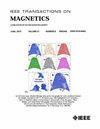具有吸收边界条件和表面电流边界条件的Maxwell特征值问题的层次混合有限元法
IF 2.1
3区 工程技术
Q3 ENGINEERING, ELECTRICAL & ELECTRONIC
引用次数: 0
摘要
提出了一种具有吸收边界条件(ABC)和表面电流边界条件(SCBC)的三维Maxwell特征值问题的混合有限元方法。在该MFEM中,可以使用包含矩阵$\bar {\bar {N}}$和$\tilde {N}$的约束方程去除零模态(包括直流杂散模态和零物理模态),其中$\bar {\bar {N}}$表示完全和不完全层次向量基函数(HVBFs)的零空间矩阵;$\tilde {N}$是$\bar {\bar {N}}$的子矩阵。数值实验结果表明,对于具有多个不连通完美电导体边界的计算域,MFEM比树-共树法、基于四面体网格的混合砂浆-单元法和基于高斯定律的MFEM效率更高。本文章由计算机程序翻译,如有差异,请以英文原文为准。
Hierarchical Mixed Finite-Element Method for Maxwell’s Eigenvalue Problems With the Absorbing Boundary Condition and the Surface Current Boundary Condition
A mixed finite-element method (MFEM) is proposed to solve 3-D Maxwell’s eigenvalue problems with the absorbing boundary condition (ABC) and the surface current boundary condition (SCBC). In this MFEM, zero modes (including dc spurious modes and zero physical modes) can be removed using the constrained equations containing the matrices $\bar {\bar {N}}$ and $\tilde {N}$ , where $\bar {\bar {N}}$ denotes the nullspace matrix for complete and incomplete hierarchical vector basis functions (HVBFs); $\tilde {N}$ is the submatrix of $\bar {\bar {N}}$ . It can be seen from numerical experiments that the MFEM is more efficient than the tree-cotree technique, the mixed mortar-element method based on a tetrahedral mesh, and the MFEMs based on Gauss’ law for the computational domain with multiple unconnected perfect electric conductor (PEC) boundaries.
求助全文
通过发布文献求助,成功后即可免费获取论文全文。
去求助
来源期刊

IEEE Transactions on Magnetics
工程技术-工程:电子与电气
CiteScore
4.00
自引率
14.30%
发文量
565
审稿时长
4.1 months
期刊介绍:
Science and technology related to the basic physics and engineering of magnetism, magnetic materials, applied magnetics, magnetic devices, and magnetic data storage. The IEEE Transactions on Magnetics publishes scholarly articles of archival value as well as tutorial expositions and critical reviews of classical subjects and topics of current interest.
 求助内容:
求助内容: 应助结果提醒方式:
应助结果提醒方式:


